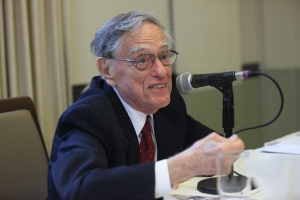Department History
“I send you here with a deposit check for $12,000 as a contribution to the fund for Chinese Learning in your university.” This letter, signed by “Dean Lung, a Chinese person”, was written to Columbia President Seth Low by the valet of University Trustee General Horace Walpole Carpentier in 1901. Dean Lung’s remarkable generosity prompted Carpentier to give additional donations totaling $200,000 in honor of his friend and employee for the endowment of Chinese studies at the University. Thus was founded what would become the Department of East Asian Languages and Cultures. In 1902 the University appointed its first professor of Chinese, Friedrich Hirth, previously of the University of Munich. Hirth began with the intention of using his own books to support the study of China at Columbia, but in the same year the University received a substantial donation of books from the government of imperial China, founding the University’s Chinese book collection, which would form the basis of what is now the C.V. Starr East Asian Library. Later holders of the founding Dean Lung Professorship have included L. Carrington Goodrich, Hans Bielenstein, and its current occupant Madeleine Zelin.

Students from Asia had been coming to study at Columbia since the late 1800s. In the early decades of the twentieth century, a number of them, including Chinese intellectual leader Hu Shih, were attracted to Columbia by the philosopher and educator John Dewey. Ryusaku Tsunoda, who first arrived on campus in 1917 as a student of Dewey, stayed on to become the founder of Japanese studies in the Department. In 1929 the University appointed Tsunoda the curator of the new Japanese library collection contributed by the Japanese Imperial Household and Baron Iwasaki of Mitsubishi. In his classes on Japanese literature and cultural history, Tsunoda inspired many of the founding generation of Asia scholars, including Columbia’s Wm. Theodore de Bary and Donald Keene. With the expansion of the Department to include Japan, in 1938 its name was changed to Department of Chinese and Japanese.
The beginning of Columbia’s tradition of scholarly excellence in East Asian studies thus coincided with the earliest years of Asian studies in the United States. Well before the Second World War spurred an expanded interest in Asia, the Department established Columbia as one of the few American universities teaching Asian languages, history, literature, religion, and politics.
To address the lack of English sources for undergraduate courses on East Asia, in the 1950s Wm. Theodore de Bary, together with Burton Watson and Donald Keene, launched an ambitious project to translate Asian texts. The resulting series – beginning with Sources of Japanese Tradition, Sources of Chinese Tradition, and Sources of Indian Tradition – now consists of over 150 titles produced by the University Committee on Asia and the Middle East and Columbia University Press since 1958 and is a crucial foundation for the Department’s undergraduate courses in particular.
Korean studies, which began at Columbia with a book collection and language instruction during the 1930s, was formally included in 1962 in the renamed Department of East Asian Languages and Cultures. Gari Ledyard taught Korean history from 1964 to 2000, overseeing a remarkable expansion in Korean studies.
In 1959 Columbia was named a national center under the new National Defense Education Act. In the more than four decades since then, the U.S. Department of Education has continuously supported East Asian studies at Columbia with substantial annual grants for faculty salaries, student fellowships, and public outreach.
In 2003 a generous grant from the Luce Foundation endowed a new chair in Modern Tibetan Studies in the Department and helped to underwrite Tibetan language study here as well; Columbia has recently used its own funds to put the Tibetan language program on a fully-funded basis, and the Department is thus now one of very few East Asian departments in the country to include Tibetan studies. With new positions established in early Japan, early Chinese history and archaeology, modern Korean literature, Chinese, Japanese, and Korean religions, Chinese and Japanese film, the Department is growing, and making a serious effort to shape the field of East Asian studies nationally, in important new directions. With the recent hires of Lien-Hang Nguyen (History Dept, 2016) and John D. Phan in 2017, we have established a vibrant new program in Vietnamese studies. Nguyen and Phan provide broad coverage of both premodern and modern Vietnam, from linguistic to diplomatic history. They were joined in 2018 by full-time Vietnamese language lecturer and former American embassy trainer Chung Nguyen, who directs the Vietnamese language program.

During the 1980s, 1990s, and early 2000s, undergraduate interest in Asia rose sharply, while the Department’s graduate programs have produced successive new generations of Asia scholars. With an illustrious professorial faculty now standing at twenty-six members and a nationally leading language faculty of more than thirty lecturers; with a placement rate of nearly one hundred per cent in academic jobs for its PhD graduates in the last decade or more: and with both its undergraduate and MA students going on either to further academic study or to significant non-academic positions in the East Asia field, the Department is a leading participant in the unprecedented flourishing of East Asian studies in the new century, when the study of this part of the world has become integral to undergraduate general education and part of the disciplinary mainstream of the humanities and social sciences.
More than a century after the founding gift in Chinese, the Department and the University boast a faculty, library, and record of educational innovation and service to East Asian studies undreamed of in the days of the generous valet Dean Lung.

